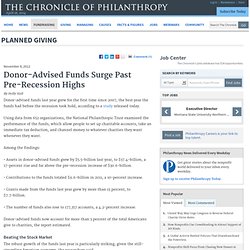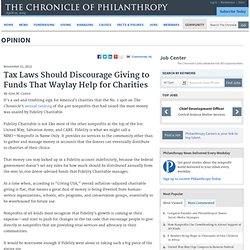

FEP2012Report.pdf (application/pdf Object) Donor-Advised Funds Surge Past Pre-Recession Highs - Planned Giving. By Holly Hall Donor-advised funds last year grew for the first time since 2007, the best year the funds had before the recession took hold, according to a study released today.

Using data from 652 organizations, the National Philanthropic Trust examined the performance of the funds, which allow people to set up charitable accounts, take an immediate tax deduction, and channel money to whatever charities they want whenever they want. Among the findings: • Assets in donor-advised funds grew by $5.5-billion last year, to $37.4-billion, a 17-percent rise and far above the pre-recession increase of $30.6-billion. • Contributions to the funds totaled $9.6-billion in 2011, a 10-percent increase. • Grants made from the funds last year grew by more than 13 percent, to $7.7-billion. Tax Laws Should Discourage Giving to Funds That Waylay Help for Charities - Opinion. By Alan M.

Cantor It’s a sad and troubling sign for America’s charities that the No. 2 spot on The Chronicle’s annual ranking of the 400 nonprofits that had raised the most money was snared by Fidelity Charitable. Fidelity Charitable is not like most of the other nonprofits at the top of the list: United Way, Salvation Army, and CARE. Fidelity is what we might call a NINO—Nonprofit in Name Only. It provides no services to the community other than to gather and manage money in accounts that the donors can eventually distribute to charities of their choice. That money can stay locked up in a Fidelity account indefinitely, because the federal government doesn’t set any rules for how much should be distributed annually from the over 50,000 donor-advised funds that Fidelity Charitable manages.
It would be worrisome enough if Fidelity were alone in taking such a big piece of the giving pie. But donor-advised funds are gaining rapidly for other reasons, too. For example, Ray D. [INFOGRAPHIC] The Economic Impact of the Nonprofit Sector. A couple of weeks ago, I came across this superb infographic regarding the economic impact of the nonprofit sector.
![[INFOGRAPHIC] The Economic Impact of the Nonprofit Sector](http://cdn.pearltrees.com/s/pic/th/infographic-economic-nonprofit-72387585)
This was striking to me because I personally had tried to assemble similar data on numerous occasions over the last 30 years. People have always inquired about how any businesses could survive, let alone thrive, serving this sector alone, since so little is really known by most people outside of this sector. The extent of the data presented below and the economic impact the data represents were even a mild shock to me. Infographic via USF Online Master of Public Administration My Top 3 Surprises 1. . $1.51 TRILLION in Revenue$1.45 TRILLION in Expenses$2.71 TRILLION in Assets That is economic impact is greater than most countries and truly illustrates how well managed the sector as a whole is, in my opinion.
Michael Kaiser: LYBNTS and SYBNTS. Gala events have been a mainstay of arts funding for decades, but for many arts organizations the bloom is off the rose.

There has been a proliferation of special events in almost every city, corporations are purchasing far fewer tables than they did in the past, and the current state of the economy has affected gala sales as it has every aspect of our fundraising efforts. This has had a major impact on total fundraising revenue. Galas are not just great sources of revenue, they are also the best prospecting opportunities for arts organizations. The friends our current donors bring to our special events are the best prospects we have; they have already come to one of our events and have a friend or associate who considers us worthy of support. Smart arts organizations devote a great deal of time on follow-up with their gala guests and typically find that a high percentage of their new donors were introduced to their organizations through a special event.
2012 DMFA Acquisition Package of the Year: Covenant House Paint Can. [Editor's note: Last month, the Direct Marketing Fundraisers Association (DMFA) held its annual Package of the Year Awards luncheon to honor the winning packages.

Through the end of the year, FundRaising Success will highlight some of the winners here in Today in Fundraising.] Right from the onset, Convenant House established a goal to acquire true mission donors. "The goal was to connect with the prospect's emotions, and then sell the cause later," says Tom Gaffny, principal of Tom Gaffny Consulting, who worked on the package along with Wilson & Associates. Pamela Barden — Setting a Course for Growth. It's one of my favorite seasons of the year — the release of the annual Chronicle of Philanthropy Philanthropy 400 listing.

I always enjoy browsing the report to see who's on, who's off and who's gaining ground. But let's face it. That report is about 400 nonprofits; that leaves 1,079,700 more in the United States alone that didn't make the list. Yet, the work they are doing is important. Regardless if your goal is to break into the 400 listing or not, we all know that more net income would be a great assistance to our programs. Successful nonprofits don't say 'goodbye' easilyThe 2012 Fundraising Effectiveness Survey Report from the Association of Fundraising Professionals and the Urban Institute found that in 2011, every 100 donors gained through acquisition was offset by 107 donors lost through attrition. Of course, some donors stop giving because of death or a change in income; it's hard to argue with those causes.